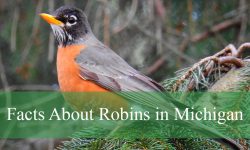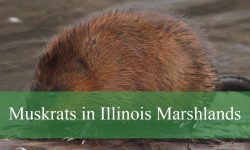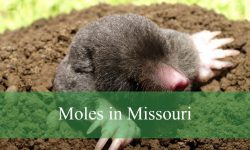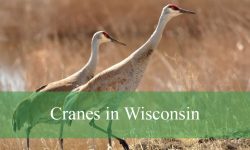Caterpillars With Red Heads use their coloring to fit in with their surroundings or to imitate harmful species. These caterpillars are common in many parts of the United States, particularly the East, and they frequently ruin gardens. These are a few common red-headed caterpillars found throughout North America.
A few common Caterpillars With Red Heads
1. Tetrio Sphinx Caterpillar
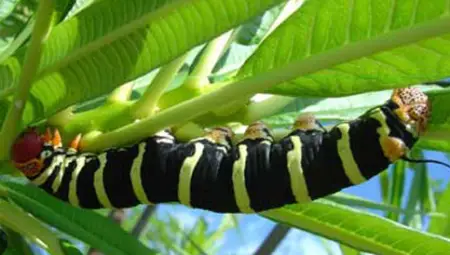
The Tetrio Sphinx Caterpillar, or Pseudosphinx tetrio, is a rare species in the United States. It is found in Southern and Central Peninsular Florida. It is distinguished by its black body with yellow bands and red head. This species has a distinct combination of red, yellow, and orange-red prolegs, in contrast to its relatives. It is quite picky about who it hosts, preferring fragrant plants like jasmine and frangipani in gardens.
2. Rosy Maple Moth Caterpillar
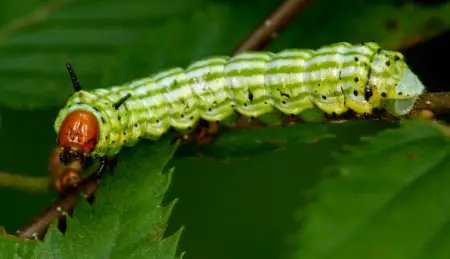
The Rosy Maple Moth Caterpillar (Dryocampa rubicunda) exhibits a vibrant green body adorned with yellow decorations as it matures. Its head can be brown, red, or red-brown, with the brightest red hue appearing during the first two instars.
3. Bedstraw Hawkmoth Caterpillar
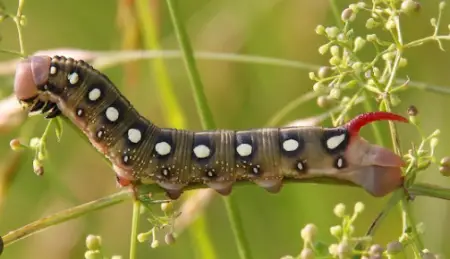
Typically feeding on bedstraw, the Bedstraw Hawkmoth Caterpillar (Hyles gallii) develops a red head. Its body might be black or reddish-brown. It is mostly found in the northern United States and southern Canada, but it can be found on both sides of the Rocky Mountains. Its hindwings still have red tones as an adult moth.
4. Splendid Dagger Caterpillar
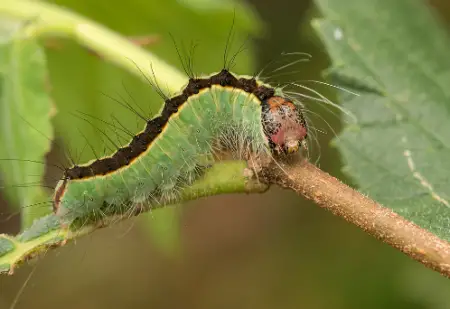
The Acronicta superans, often known as the Splendid Dagger Caterpillar, has a green body and a reddish-brown head. It is distinguished by a noticeable brown mid-dorsal band that is bordered in yellow and where long hairs protrude. These caterpillars are regularly observed in the Northeastern United States, where they are found on plum, apple, and ash trees.
5. Lily Caterpillar
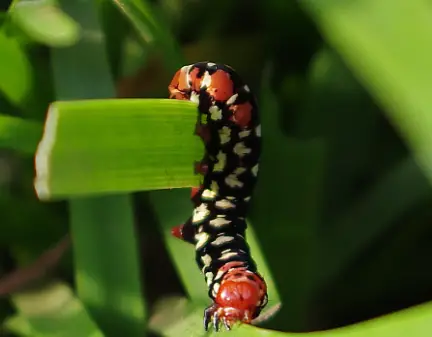
Lily caterpillars (Spodoptera picta) have a bright red head and a mostly black body with white and yellow stripes that remain consistent throughout the caterpillar to moth stage of development. The prolegs’ deeper yellow color is another unique characteristic. The long, thin green leaves of their host plants are consumed by these caterpillars as they feed on a variety of lily species.
6. White-Marked Tussock Moth Caterpillar
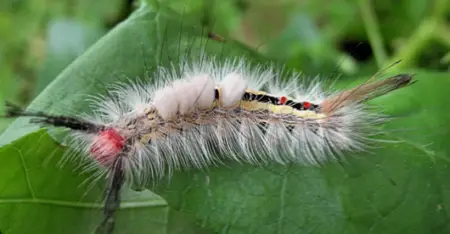
The multicolored body of the White-Marked Tussock Moth Caterpillar (Orgyia leucostigma) is enhanced by long white hairs and black tufts that resemble antennae. Its huge red head and red dots along the mid-dorsal area give it a striking appearance. The remainder of its body is mostly black with yellow stripes for contrast. This species is usually seen on rose leaves and flowers in gardens, but it also feeds on fruit and hardwood trees like apples and oaks. These caterpillars finally perish from a transmissible disease, even in the face of repeated outbreaks.
7. Interrupted Dagger Caterpillar
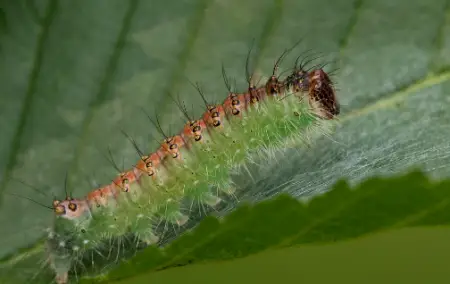
The distinctive features of the Interrupted Dagger Caterpillar (Acronicta interrupta) are its sizable red head and a black dorsal coat with tiny orange to brown dots. Its body has long white hair that grows sporadically and noticeable white stripes on the sides. These caterpillars are notorious for wreaking havoc in gardens, parks, and wooded areas. They mostly consume the leaves of apple, oak, birch, and apricot trees. These moths become more muted shades of gray and black as adults, losing their vivid red coloring. It is advisable to manage these caterpillars in order to avoid possible damage.
8. Hieroglyphic Moth Caterpillar
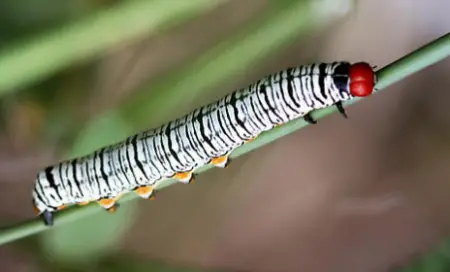
The Hieroglyphic Moth Caterpillar (Diphthera festiva) has a reddish-brown head and a distinctly white base with black bands that contrast with it. Likewise, the mature moth displays an eye-catching blend of black and white-cream. Typically found in Central America and the Florida peninsula, these caterpillars are frequently managed with insecticides when epidemics occur.
9. Dull Firetip Caterpillar
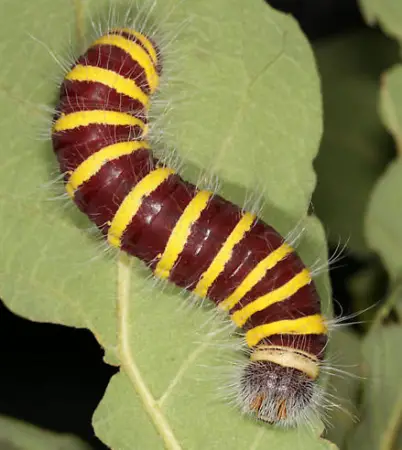
Usually visible in the summer, the Dull Firetip Caterpillar (Apyrrothrix araxes) is a unique-looking insect that produces only one brood annually in North America. These caterpillars are only found in the Southwestern region of the United States, and they only eat the leaves of oak trees in oak forests. The mature moths are less noticeable due to their camouflaging dark hue.
10. Silver-Spotted Skipper Caterpillar
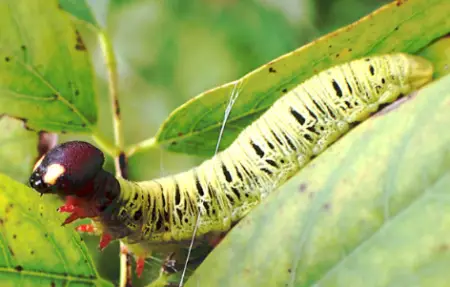
Silver-spotted Skipper Caterpillar, or Epargyreus clarus, is frequently seen climbing plants in gardens and feasting on vines and vine leaves. This species exhibits vivid contrasts in both its caterpillar and adult moth stages. Even as an adult moth, the caterpillar maintains its yellow base color, along with a brown-red head and huge yellow-orange eyes. The Silver-Spotted Skipper moth is primarily brown in color with characteristic yellow markings.
11. Long-Tailed Skipper Caterpillar
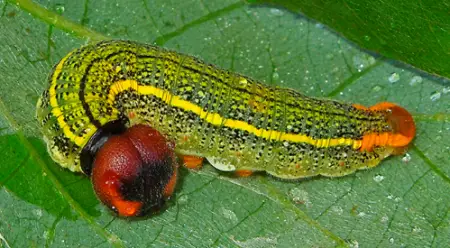
The Long-Tailed Skipper Caterpillar (Urbanus proteus), shares a similar appearance to Horace’s Duskywing Caterpillars, with a green body that contrasts with a black and red head. Large red eyes and small yellow dots around the dorsum in later stages are characteristics that help identify this species. Certain caterpillars eventually grow yellow stripes as well. If you locate them in a garden, they usually eat on wisteria leaves, although they can also be found on wild pea family plants. Up to three broods a year are frequently observed in the southern regions of North America.
12. Horace’s Duskywing Caterpillar
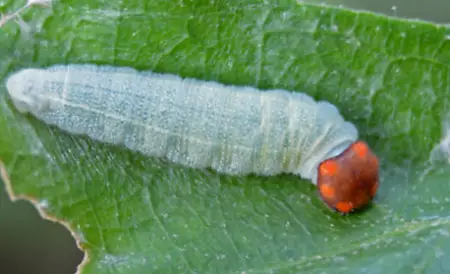
By eating on tree leaves, especially those of live oak, red oak, and white oak, the Horace’s Duskywing Caterpillar (Erynnis horatius) can cause harm in parks, gardens, and wooded areas. The caterpillar has a characteristic red or brown-red head and a green body with subtle light green to white streaks that resemble the veins of oak leaves.
13. White-Lined Sphinx Caterpillar
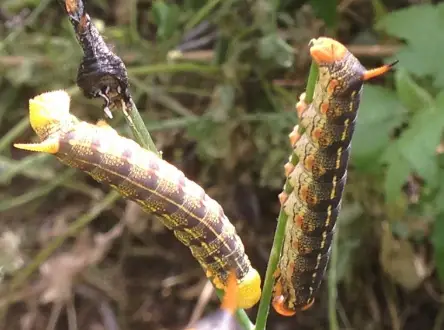
With a colorful body and a lengthy history in North America, the White-Lined Sphinx Caterpillar (Hyles lineata) was formerly used as food by native people. It is recognized as a pollinator as an adult moth. Nonetheless, the caterpillar is commonly acknowledged as a pest that seriously harms gardens and crops. Host plants may get completely defoliated as a result of recurring outbreaks.
14. Fir Tussock Moth Caterpillar
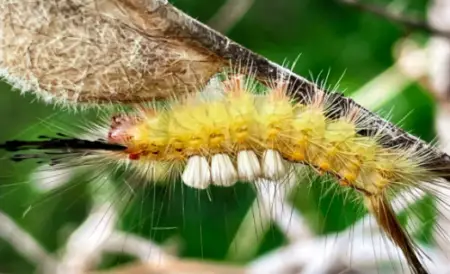
The Fir Tussock Moth Caterpillar (Orgyia detrita) is characterized by its fuzzy look, which can irritate skin when handled, and a red head that appears on it during its life cycle. Its dorsal side is green and black with orange dots, and it has several glandular formations close to the head that give it an appearance that could be toxic. This caterpillar distinguishes out for its unique morphological characteristics, especially its lengthy black tufts. Its main food source is fir, but it also feeds on oak, maple, willow, and hackberry trees.
15. Common Buckeye Caterpillar
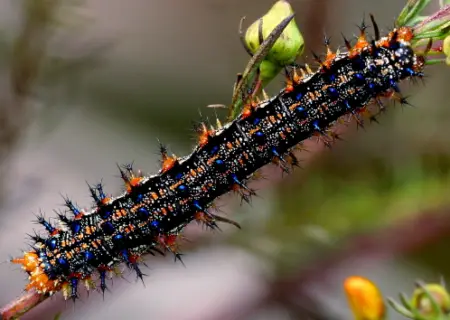
The color changes of the Common Buckeye Caterpillar (Junonia coenia) are gradual; it begins as a dark appearance and progresses to a black body with small white dots, a brown or red head, and sporadic red or brown patches on the sides. With its scant black spines, it shows particular host plant preferences, usually narrowleaf plantains. Eventually, this species changes into a brown butterfly, identified by the large eyespots on its wings.
16. Western Red-Humped Caterpillar
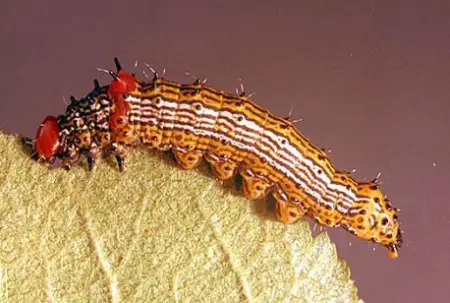
The Western Red-Humped Caterpillar (Oedemasia salicis) is a caterpillar that first appears yellow to orange in color. It eventually reaches a size of three times its original size and begins to display a mixture of yellow and black or orange and black. The caterpillar has a bright red head in its later growth phases, and it also has black spines that resemble poison to ward off predators. Its crimson, hump-shaped structure at the back of its head adds to its unique appearance and raises its perceived threat level.
17. Red-Humped Caterpillar
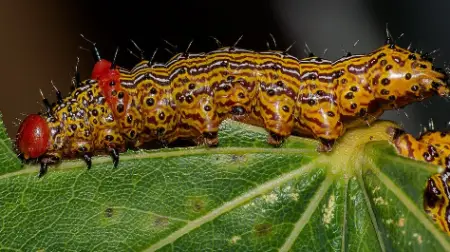
The juvenile Red-Humped Caterpillar (Oedemasia concinna) changes into an adult form with a black and yellow body and a bright red head. Some people’s heads may have subtle red to brown tones. In the years after an epidemic, these caterpillars have the capacity to completely defoliate trees and do considerable harm to the ecosystem. Use of insecticides or other chemicals may be required if they are eating on leaves that are out of reach. It is recommended to remove these caterpillars right away.
18. Azalea Caterpillar
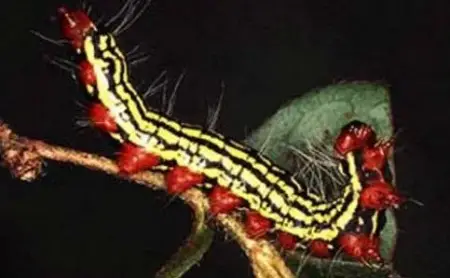
The main food source for The Azalea caterpillar (Datana major), which goes through several instars as it grows, is azaleas. It looks orange or orange-brown at first, then has a characteristic red head and red prolegs. Along the dorsal side of its body, alternating stripes of black and yellow provide an eye-catching design that serves as a deterrent to prospective predators. It is well known that this type of caterpillar damages azalea plants in gardens.
19. Zebra caterpillar
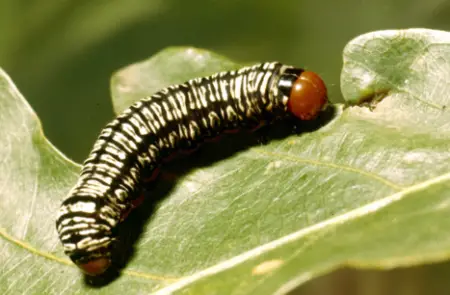
The American noctuid moth Melanchra picta, which gives rise to The Zebra caterpillar, typically consumes cultivated plants such as beets and cabbages. The characteristic color of adult moths is reddish-brown or chestnut, with purplish brown mottling on the wings and pale brown margins on the whitish hind wings. These caterpillars, which are common across the United States, usually turn into pests in the late summer and have a distinctive rolling up and down motion when they are disturbed on leaves.
People Who Read This Also Read:
- Types of Horned Caterpillars
- Types of Caterpillars With Spikes
- Types of Yellow Caterpillars
- Types of White Caterpillars
- Types of Black and Brown Caterpillars
- Types of Black and Orange Caterpillars
- Types of Black and Yellow Caterpillars
- Types of Florida Caterpillars
- Types of Moth Caterpillars
- Types of Caterpillars in Georgia


